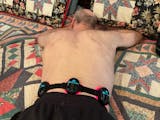Enhancing Recovery: Photobiomodulation Therapy for Distal Radius Fracture Rehabilitation
Persistent pain and functional limitations are often experienced by individuals who have suffered from distal radius fracture (DRF), even after the cast has been removed. In order to explore potential solutions, a recent study focused on the effectiveness of photobiomodulation therapy (PBMT) as an additional treatment alongside home-based exercise programs for the rehabilitation of DRF patients.
In a carefully planned triple-blinded placebo-controlled study, 50 patients with conservatively treated DRF were randomly divided into two groups to receive either active PBMT or placebo PBMT after cast removal, along with a structured home-based exercise program. The research evaluated different outcome measures such as the Patient-Rated Wrist and Hand Evaluation (PRWHE) questionnaire, night pain (NP), and use of analgesic medication (AM), at various intervals during a 26-week period following the injury.
The results uncovered convincing proof supporting the use of active PBMT as a helpful addition to rehabilitation following DRF. Noteworthy variations between groups were identified in PRWHE scores, NP, and AM intake, with the active PBMT group consistently displaying better results from 7 to 26 weeks post-injury. Importantly, meaningful enhancements favoring active PBMT were seen in overall score, pain subscore, and disability subscore at different time intervals, highlighting the therapeutic effectiveness of PBMT in reducing pain and improving functional recovery after DRF.
In summary, PBMT proves to be a secure and efficient therapeutic approach for individuals facing the difficulties of DRF rehabilitation. By incorporating it into a comprehensive exercise program that can be done at home, PBMT consistently shows beneficial results in terms of pain relief and improved functionality in the long run. These discoveries provide valuable knowledge for enhancing rehabilitation methods for DRF patients and emphasize the potential of PBMT as a non-intrusive intervention in orthopedic care.
Furthermore, the use of PBMT in DRF rehabilitation can also lead to reduced reliance on pain medications and potentially decrease the risk of long-term complications associated with surgery or prolonged immobilization. This non-invasive approach not only accelerates the healing process but also improves overall quality of life for patients by promoting faster recovery and improved range of motion.
Overall, the evidence supporting the efficacy of PBMT in DRF rehabilitation is promising and suggests that this therapy should be considered as a valuable addition to traditional treatment protocols. By incorporating PBMT into rehabilitation programs, healthcare providers can offer patients a safe and effective alternative for managing pain and improving functional outcomes following a distal radius fracture. As research in this area continues to evolve, it is clear that PBMT has the potential to revolutionize orthopedic care and enhance the overall recovery experience for individuals with DRF.
















Share:
Muscle Recovery Acceleration: Evidence Supporting Red Light Therapy
Enhancing Recovery: Transcranial Infrared Laser Stimulation for Traumatic Brain Injury